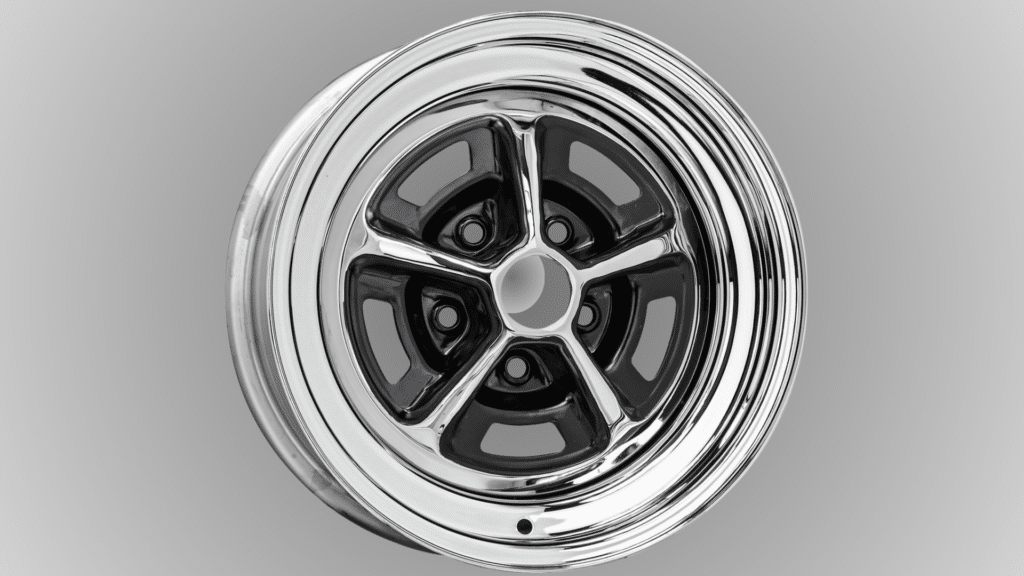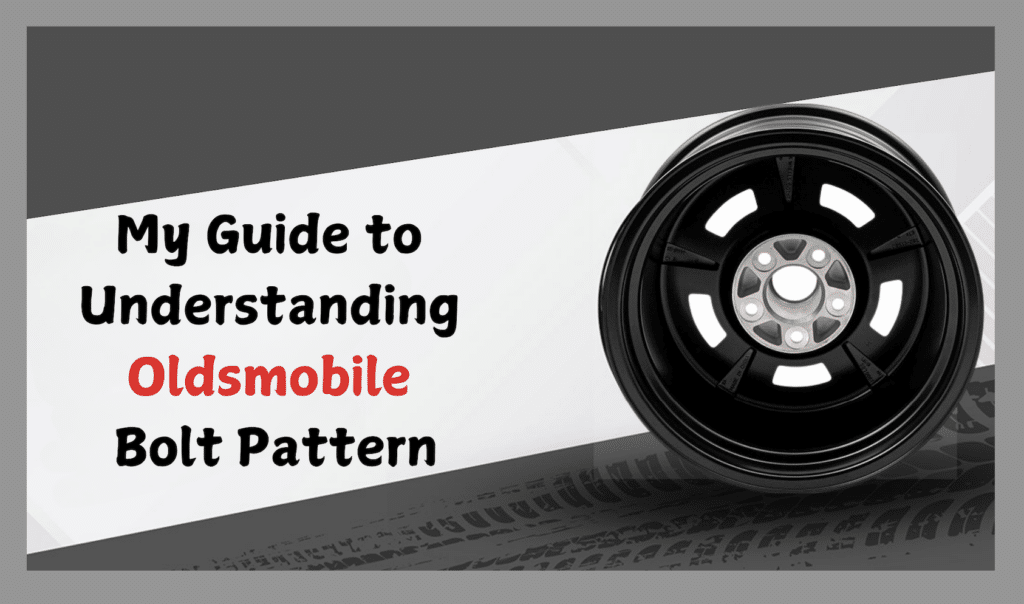Getting your wheels right matters more than you might think.Before you can swap rims or replace a damaged wheel on your Oldsmobile, you need to know one crucial detail: the bolt pattern.
It’s like a fingerprint for your car’s wheels, determining which ones will fit and which ones won’t.
If you’re here, you’re probably trying to figure out your Oldsmobile’s bolt pattern without the headache. Maybe you’re eyeing some sweet vintage rims, or you need to replace a damaged wheel. Whatever brought you here, I’ve got you covered.
In this guide, I’ll walk you through everything about Oldsmobile bolt patterns. You’ll learn how to measure them, which patterns were used on different models, and what other wheels might fit your car.
No complex agenda, no confusion – just clear answers to help you get the right wheels for your ride.
With 25+ years of working on Oldsmobiles, I know the frustration of wheel fitment issues.
Let’s solve this together.
What is the Bolt Pattern for an Oldsmobile?

Ever looked under your Oldsmobile and wondered about those holes where the wheel attaches? That’s your bolt pattern at work.
Think of it like a circle of dots – the number of lugs (or bolts) and how far apart they sit tells you your bolt pattern.
I’ll break it down in plain English: A bolt pattern has two main numbers. Take “5×4.75” for example. The first number (5) tells you how many lug nuts your wheel needs.
The second number (4.75) shows how wide that circle of lugs is in inches. This measurement is crucial – even being off by a tiny bit means your new wheels won’t fit.
Most Oldsmobiles from the 1960s through the 2000s used these common patterns:
- 5×4.75 inches (also known as 5×120.7mm): Found on many classic models like the Cutlass and 442
- 5×4.5 inches (5×114.3mm): Common on later models like the Alero and Intrigue
- 5×5 inches (5x127mm): Used on larger vehicles like the Custom Cruiser
A neat trick: If you’re working on an older Olds, you might have better luck searching using the inch measurements rather than millimeters. Mechanics in the ’60s and ’70s didn’t use metric!
Remember that same era Oldsmobiles often share bolt patterns with other GM cars like Buick and Pontiac. This means more wheel options for you – but always double-check the measurements to be sure.
Understanding Oldsmobile Bolt Patterns and Their Compatibility
Think of your Oldsmobile’s bolt pattern like a key that needs to match its lock perfectly. You can’t just slap any wheel on your car and expect it to work – the fit needs to be exact.
When I talk about compatibility, it’s not just about the number of lugs matching up. The circle they form (what I call the bolt circle diameter) must be spot-on too.
Even a fraction of an inch off could mean your wheels wobble or, worse, come loose while driving.
What really matters for wheel compatibility?
Center Bore Size Your Oldsmobile’s hub has a specific diameter, and your wheel needs to match it. Most Oldsmobiles use a 70.3mm center bore – this is like the centering pin that keeps everything aligned.
Offset and Backspacing These measurements tell you how your wheel sits in the wheel well. The wrong offset could mean your wheels stick out too far or rub against your suspension.
For most Oldsmobile models, you’ll want an offset between +35mm and +45mm.
Something many people miss is that while many GM vehicles share similar bolt patterns, they might have different load ratings.
For example, a wheel from a lighter Alero won’t necessarily work safely on a heavier Custom Cruiser, even if the bolt pattern matches.
Before you buy wheels from another vehicle, check these crucial points:
- Load rating matches or exceeds your car’s needs
- Center bore is correct (or can be modified with hub rings)
- Wheel offset works with your model
- Brake caliper clearance is sufficient
Remember, just because a wheel bolts on doesn’t always mean it’s safe to use. Your safety depends on getting this right.
List of the Correct Bolt Pattern for Different Oldsmobile Models
Classic Oldsmobile Models (1960-1989)
| Model | Years | Bolt Pattern | Center Bore | Notes |
|---|---|---|---|---|
| 442 | 1964-1980 | 5×4.75″ (5×120.7mm) | 70.3mm | Shared pattern with most GM A-body cars |
| Cutlass | 1961-1988 | 5×4.75″ (5×120.7mm) | 70.3mm | Supreme and Salon models included |
| Delta 88 | 1965-1985 | 5×5″ (5x127mm) | 70.3mm | Heavier duty pattern for full-size models |
| Toronado | 1966-1985 | 5×5″ (5x127mm) | 70.3mm | Front-wheel drive application |
| Vista Cruiser | 1964-1977 | 5×4.75″ (5×120.7mm) | 70.3mm | Station wagon variant |
| Omega | 1973-1984 | 5×4.75″ (5×120.7mm) | 70.3mm | X-body platform |
Modern Oldsmobile Models (1990-2004)
| Model | Years | Bolt Pattern | Center Bore | Notes |
|---|---|---|---|---|
| Alero | 1999-2004 | 5×4.5″ (5×114.3mm) | 70.3mm | Last Oldsmobile model produced |
| Aurora | 1995-2003 | 5×4.5″ (5×114.3mm) | 70.3mm | Premium sedan |
| Bravada | 1991-2004 | 5×4.75″ (5×120.7mm) | 70.3mm | SUV platform |
| Intrigue | 1998-2002 | 5×4.5″ (5×114.3mm) | 70.3mm | Mid-size sedan |
| Silhouette | 1990-2004 | 5×4.5″ (5×114.3mm) | 70.3mm | Minivan platform |
| Achieva | 1992-1998 | 5×4.75″ (5×120.7mm) | 70.3mm | Compact car platform |
Important Notes:
- All measurements are factory specifications
- Some rare trim levels might have different patterns
- Always verify measurements on your specific vehicle
- Center bore tolerance: ±0.1mm
How to Identify the Correct Bolt Pattern for a Specific Oldsmobile Model?
Finding your Oldsmobile’s bolt pattern doesn’t have to be a guessing game. The easiest way starts with your car’s door jamb – there’s usually a sticker or plate there with your model’s specs.
Can’t find it? No worries. The glove box or owner’s manual often has this info too.
But let’s say you can’t find these specs. How do I measure bolt patterns the right way?
For 5-lug wheels (most common on Oldsmobiles), measure from the center of one lug to the outside edge of the farthest lug hole – not the hole next to it.
This is crucial. The distance you measure is your bolt circle diameter. For accuracy, I always use a ruler with millimeter markings since even tiny differences matter.
A pro tip I’ve learned over years of working on these cars: If you’re dealing with a wheel that’s still on the car, grab some masking tape and a measuring tape.
Place the tape’s end at the center of one lug nut, then stretch it to the outside edge of the lug nut directly across. This gives you the most accurate measurement.
Watch out for this common mistake: Don’t measure from lug to lug – this will give you the wrong number every time.
The correct measurement is from the center of one lug to the outer edge of the opposite lug hole. Think of it like measuring the radius of the circle these lugs make, then doubling it.
When all else fails, you’ve got two reliable backup options:
- Take your car to any tire shop – they can measure this in minutes with special tools
- Look up your VIN number online – many automotive databases link VINs to exact specifications
Remember, getting this measurement right is far better than gambling on a “close enough” fit. A wrong bolt pattern isn’t just inconvenient – it’s unsafe.
Comparisons Between Oldsmobile and Other Brands’ Bolt Patterns with Prices
Compatible Brand Crossover & Price Guide (Based on 2024 Market Averages)
| Brand & Model | Compatible Olds Models | Bolt Pattern | Avg. Wheel Price | Notes & Fitment Details |
|---|---|---|---|---|
| Chevrolet | ||||
| Camaro (82-92) | Cutlass, 442 | 5×4.75″ | $120-180/wheel | Direct fit, shared GM A-body platform |
| Malibu (97-03) | Alero, Intrigue | 5×4.5″ | $85-150/wheel | Same center bore, ideal budget option |
| Pontiac | ||||
| Firebird (82-92) | Cutlass, 442 | 5×4.75″ | $150-200/wheel | Perfect match, popular upgrade choice |
| Grand Prix (97-03) | Aurora, Intrigue | 5×4.5″ | $90-160/wheel | Direct fit, verify offset (35-45mm) |
| Buick | ||||
| Regal (78-87) | Cutlass Supreme | 5×4.75″ | $100-170/wheel | Identical specs shared wheel designs |
| LeSabre (92-99) | Eighty-Eight | 5×5″ | $110-190/wheel | Requires matching center bore |
| Cadillac | ||||
| DeVille (94-99) | Aurora | 5×4.5″ | $200-300/wheel | Premium option, check load rating |
| Seville (92-97) | Ninety-Eight | 5×5″ | $180-280/wheel | Higher-end alternative, perfect fit |
Price Ranges for Different Wheel Types:
| Wheel Type | Price Range | Compatibility Notes |
|---|---|---|
| OEM Stock | $80-150/wheel | Best fit, limited availability |
| Aftermarket New | $120-250/wheel | Wide selection, verify specs |
| Performance | $200-400/wheel | Enhanced design, lighter weight |
| Vintage/Classic | $150-500/wheel | Collector value, rare finds |
| Custom Forged | $400-1000+/wheel | High-end, special order |
Important Pricing Factors:
- Prices shown are averages for used wheels in good condition
- New wheel prices can be 30-50% higher
- Custom finishes add $50-100 per wheel
- Chrome options typically add $75-150 per wheel
- Professional mounting/balancing: $15-25 per wheel additional
Note: Prices reflect 2024 market averages. Local prices may vary.
How to Maintain Bolt Patterns on Your Oldsmobile?
Regular Inspection and Cleaning
I can’t stress enough how important it is to keep your wheel mounting surfaces clean.
Every time you rotate your tires (which should be every 5,000-7,000 miles), take a close look at those bolt holes.
Any rust or dirt buildup can mess with how your wheels sit.
What do I do? Use a wire brush to clean the mounting surface and the lug holes. Pay special attention to the center bore – that’s where most corrosion likes to hide.
A light coat of anti-seize on the hub center (not the lug studs!) can prevent your wheels from getting stuck.
Ensuring Proper Torque on Lug Nuts
Your lug nuts need to be just right – not too tight, not too loose. Most Oldsmobiles require between 85-100 ft-lbs of torque.
What’s the crucial part? Always tighten them in a star pattern. Think of drawing a star when you’re tightening them – this ensures even pressure.
A quick breakdown of the proper sequence:
- Hand-tighten all lug nuts
- Torque to 50% of spec in a star pattern
- Final torque to full spec
- Recheck after 50-100 miles
Addressing Wear and Tear
Watch out for these warning signs that need immediate attention:
- Oval-shaped lug holes (means your lugs were loose)
- Rust around the center bore
- Cracked or stretched lug studs
- Wobbling or vibration at highway speeds
If you spot stripped threads or damaged studs, don’t wait – replace them immediately. A single bad stud can put extra stress on the others. When replacing studs, always use OEM-quality parts rated for your vehicle’s weight.
Remember, these maintenance steps might seem small, but they’re keeping that two-ton vehicle safely connected to its wheels. Better to spend a few minutes checking now than hours dealing with a problem later.
Conclusion
As someone who’s spent years working on Oldsmobiles, I know firsthand that getting your bolt patterns right isn’t just about fitting nice wheels – it’s about keeping you safe on the road.
Remember, most Oldsmobiles use either a 5×4.75″ pattern (older models) or a 5×4.5″ pattern (newer ones). If you’re unsure about yours, take that extra minute to measure it properly.
It’s better to measure twice than buy the wrong wheels.
I’ve covered how to identify your pattern, which wheels fit your car, and how to maintain them properly. The beauty of Oldsmobile’s bolt patterns is that they’re shared with many other GM vehicles, giving you plenty of options for replacement wheels.
Whether you’re restoring a classic 442 or maintaining an Alero, keeping these basics in mind will save you time, money, and headaches down the road. Take care of those bolt patterns, and they’ll take care of you.
Frequently Asked Questions
Can I Use Wheels From Other GM Cars on My Oldsmobile?
Yes, many GM vehicles share bolt patterns with Oldsmobiles. For example, if you have a 1980s Cutlass (5×4.75″), you can use wheels from same-era Buicks and Pontiacs.
Just remember to check the center bore size and offset to ensure proper fitment.
What Happens If I Install the Wrong Bolt Pattern Wheels?
Using the wrong bolt pattern is dangerous. Your wheels won’t center properly, causing vibration, uneven tire wear, and possible wheel separation.
Never use adapters or modify bolt holes – it’s not worth risking your safety.
How Often Should I Check My Lug Nut Torque?
Check your lug nut torque every time you rotate your tires (every 5,000-7,000 miles) and after any wheel service.
Also, recheck them after 50-100 miles of driving following any wheel installation. Most Oldsmobiles need 85-100 ft-lbs of torque.
Why Does My Oldsmobile Have Different Bolt Patterns Than Listed?
Some rare models or special editions came with different bolt patterns. Also, previous owners might have modified the car.
When in doubt, always measure your specific vehicle rather than relying solely on charts.
How Do I Measure My Bolt Pattern Without Special Tools?
For a 5-lug pattern, measure from the center of one lug to the outside edge of the lug hole farthest from it (not the adjacent one).
You can use a regular tape measure, but for best results, do this measurement with the wheel of the car.


